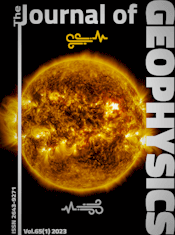Seismological evidence for lateral magma intrusion during the July 1978 deflation of the Krafla volcano in NE-Iceland
Article Sidebar

Vols. 1-18 (1924-1944), ISSN 0044-2801
Main Article Content
Abstract
The July 1978 deflation of Krafla volcano in the volcanic rift zone of NE-Iceland was in most respects typical of the many deflation events that have occurred at Krafla since December 1975. Separated by periods of slow inflation, the deflation events are characterized both by rapid subsidence and volcanic tremor in the caldera region, as well as extensive rifting in the fault swarm that transects the volcano. Earthquakes increase in the caldera region shortly after deflation starts and propagate along the fault swarm away from the central part of the volcano, sometimes as far as 65 km. The deflation events are interpreted as the result of subsurface magmatic movements, when magma from the Krafla reservoir is injected laterally into the fault swarm to form a dyke. In the July 1978 event, magma was injected a total distance of 30 km into the northern fault swarm. The dyke tip propagated with a velocity of 0.4-0.5 m/s during the first 9 h, but the velocity decreased as the length of the dyke increased. Combined with surface deformation data, these data can be used to estimate the cross-sectional area of the dyke and the driving pressure of the magma. The cross-sectional area is variable along the dyke and is largest in the regions of maximum seismic energy release. The average value is about 1,200 m2. The pressure difference between the magma reservoir and the dyke tip was of the order of 10-40 bars and did not change much during the injection.
 ARK: https://n2t.net/ark:/88439/y057911
ARK: https://n2t.net/ark:/88439/y057911
Permalink: https://geophysicsjournal.com/article/134
Article Details
References
Bjornsson, A., Saemundsson, K., Einarsson, P., Tryggvason, E., Granvold, K. (1977) Current rifting episode in North Iceland. Nature 266:318-323
Brandsdottir, B., Einarsson, P. (1979) Seismic activity associated with the September 1977 deflation of the Krafla central volcano in NE Iceland. J. Volcanol. Geothermal Res. in press
Einarsson, P. (1976) Relative location of earthquakes within the Tjornes Fracture Zone. Soc. Sci. Isl. Greinar V, pp. 45-60
Einarsson, P. (1978) S-wave shadows in the Krafla caldera in NE-Iceland, evidence for a magma chamber in the crust. Bull. Volcanol. 41:1-9
Einarsson, P. (1979) Seismicity and earthquake focal mechanisms along the mid-Atlantic plate boundary between Iceland and the Azores. Tectonophysics 55:127-153
Gerke, K., Moller, D., Ritter, B. (1978) Geodatische Lagemessungen zur Bestimmung horizontaler Krustenbewegungen in NordostIsland. Wissenschaftliche Arbeiten der Lehrstuhle fur Geodasie, Photogrammetrie und Kartographie an der Technischen Universitat Hannover, Nr. 83:23-33
Gronvold, K., Makipaa, H. (1978) Chemical composition of Krafla lavas 1975-1977. Nordic Volcanological Institute, Report 78 16, 49 pp.
Kushiro, I., Yoder, H.S., Mysen, B.O. (1976) Viscosities of basalt and andesite melts at high pressure. J. Geophys. Res. 81:6351-6356
Lahr, J.C., Ward, P.L. (1975) HYPOELLIPSE: A computer program for determining local hypocentral parameters, magnitude, and first motion pattern. U.S. Geol. Surv. Open-File Report
Saemundsson, K. (1977) Geological map of Iceland, sheet 7, NE-Iceland. Icelandic Geodetic Survey and Museum of Natural History
Shaw, H.R. (1972) Viscosities of magmatic silicate liquids: An empirical method of prediction. Am. J. Sci. 272:870-893
Tryggvason, E. (1978a) Tilt observations in the Krafla-Myvatn area 1976-1977. Nordic Volcanological Institute, Report 78 02 45 pp.
Tryggvason, E. (1978b) Distance measurements in 1977 in the Krafla-Myvatn area and observed ground movements. Nordic Volcanological Institute, Report 78 10, 47 pp.
Tryggvason, E. (1978c) Subsidence events in the Krafla area. Preliminary report based on tilt and distance measurements. Nordic Volcanological Institute, Report 78 14, 65 pp.











